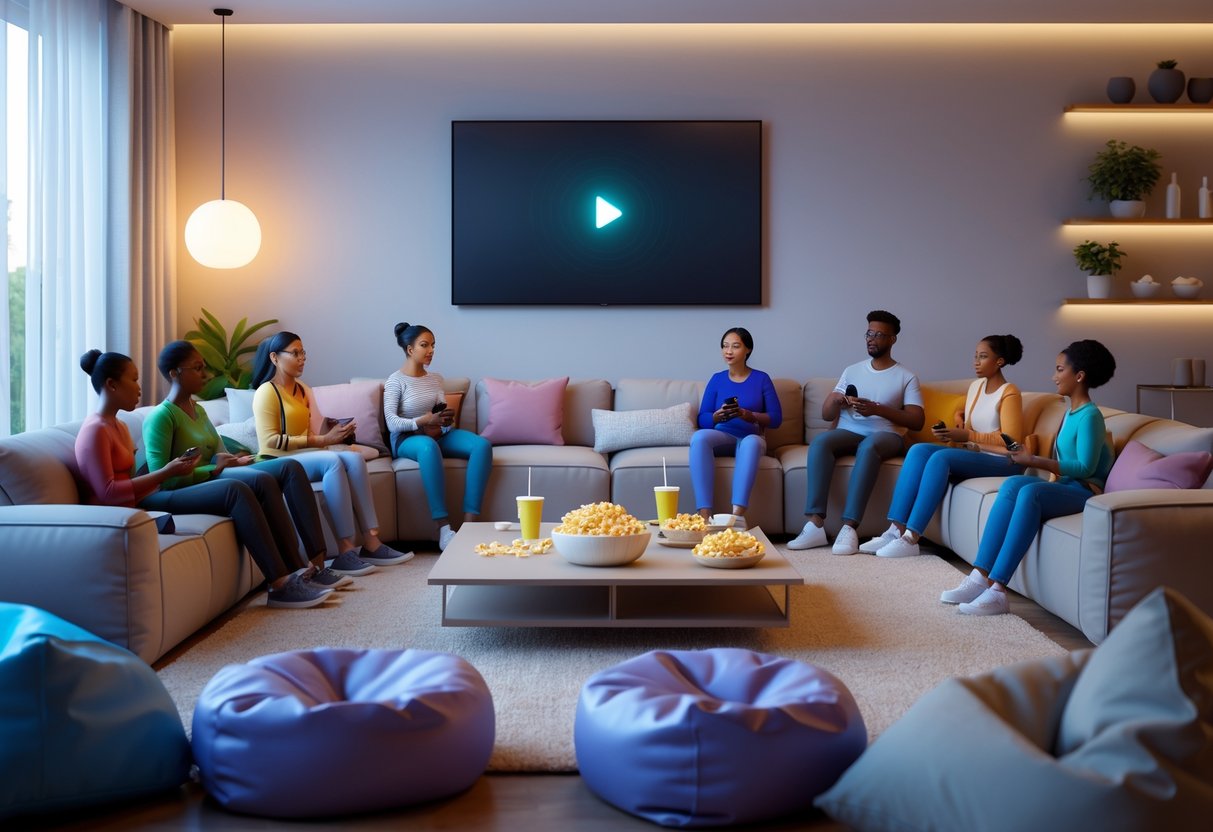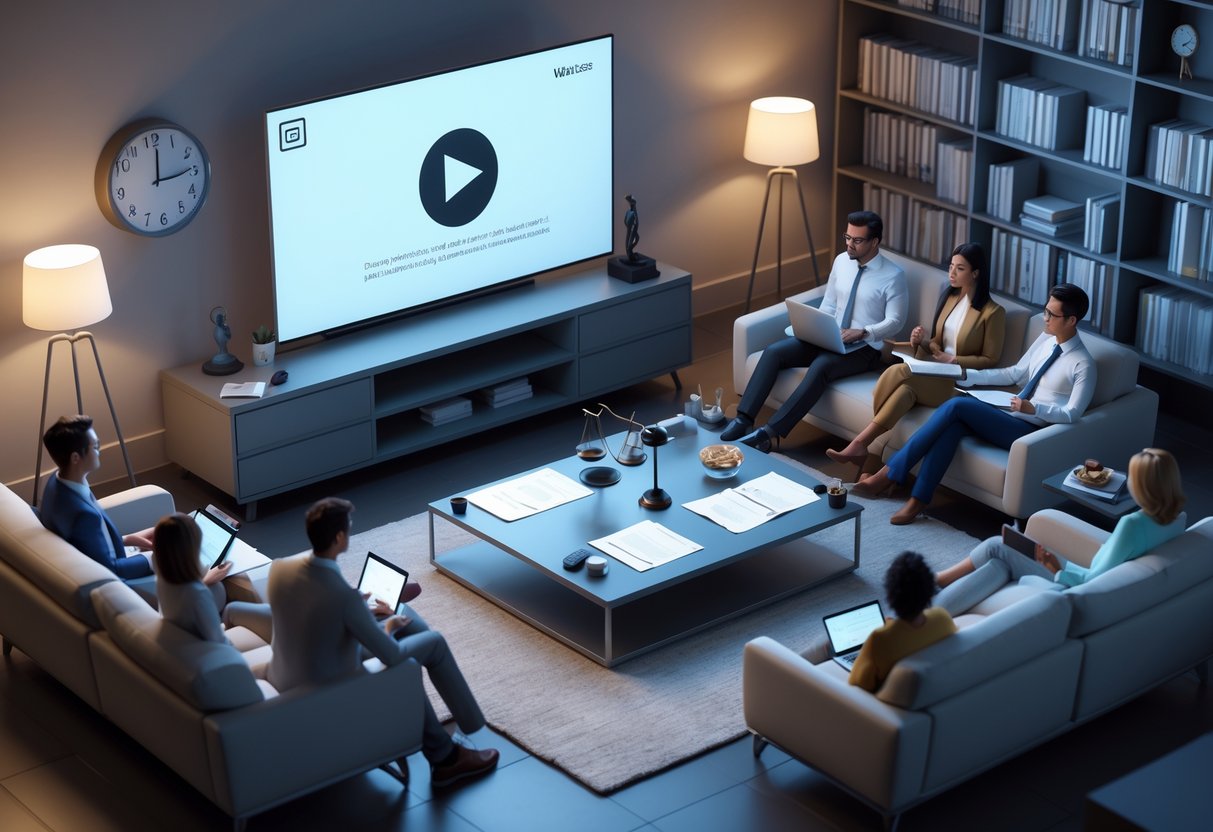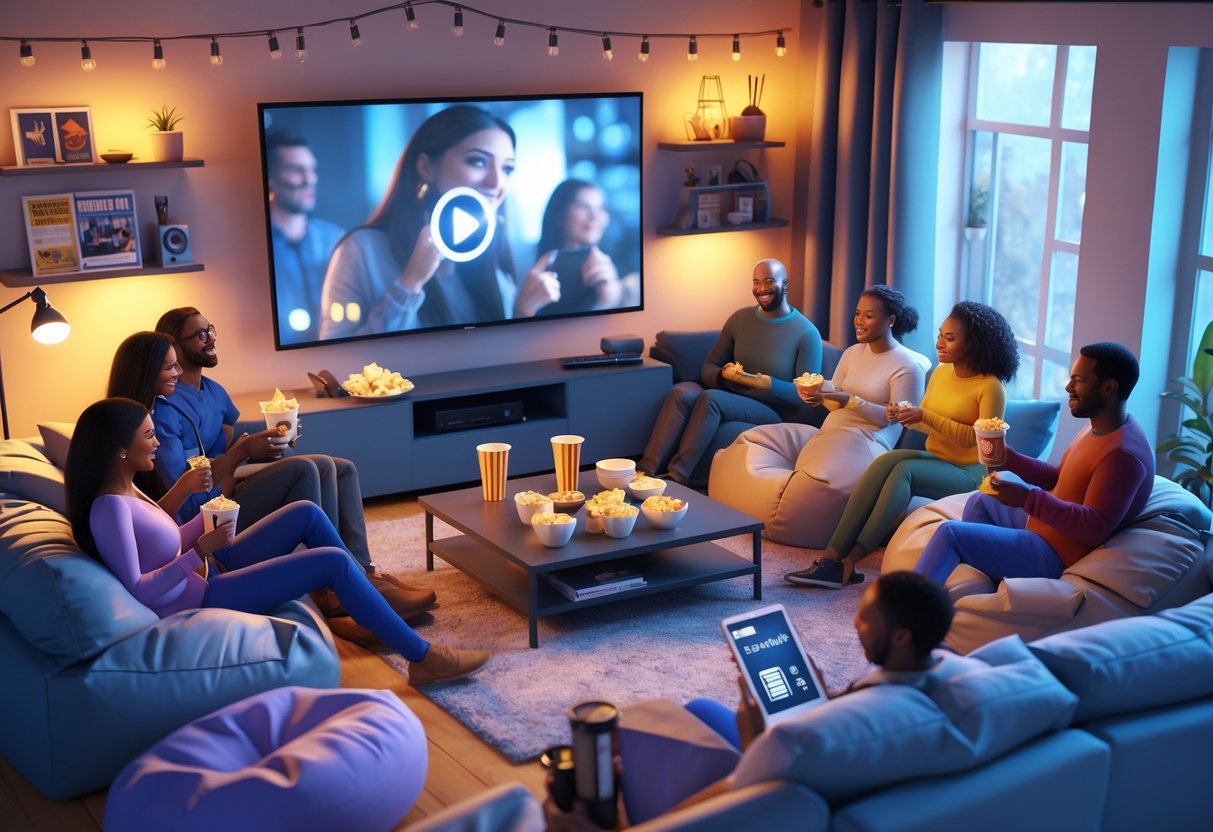Watch Party Guidelines: Rules, Etiquette and Hosting Tips
Updated On: October 24, 2025 by Aaron Connolly
Essential Watch Party Guidelines
If you stick to watch party guidelines, you’ll keep everyone comfortable and help things go off without a hitch. Age limits, acceptable behaviour, platform rules, and a few legal things—these are all things every host should know.
Age Restrictions and Eligibility
Most streaming platforms only let people 13 or older use their services. Netflix and Disney+ actually bump that up to 18 if you want to make an account without a parent’s okay.
Double-check your platform’s rules before you send out invites. If you’re mixing age groups, make sure the movie or show fits your youngest guest.
Key age considerations:
- The account holder has to meet the platform’s age rules
- Content ratings (U, PG, 12, 15, 18) decide who can watch
- Adults need to supervise younger viewers for age-restricted stuff
- Some services limit how many people can watch at once, depending on your subscription
If you’re a parent hosting for kids, don’t just trust the rating—give the movie a quick scan. Even U-rated films sometimes bring up topics you might want to chat about first.
Permitted and Prohibited Behaviour
Watch parties go best when everyone acts respectfully. If someone ruins the vibe or harasses others, that breaks the rules.
Good activities:
- Share reactions or comments, but pick your moments
- Bring snacks or drinks you cleared with the host
- Snap some photos for yourself
- Join in on games or discussions if planned
Not okay:
- Recording or streaming the main content
- Using your phone the whole time
- Spoiling surprises for first-timers
- Drinking alcohol if anyone’s underage
Lay out your expectations in the invite. Most hosts do a quick “house rules” rundown before hitting play.
Personal and Non-Commercial Use
Keep your watch party private and for fun, not profit. Charging for entry or advertising a business usually breaks the platform’s rules.
Don’t ask guests for money to attend. If you do, you turn a home hangout into a public screening, and that’s a whole legal mess.
What’s fine:
- Invite friends and family for free
- Share snacks or drinks casually
- Take personal photos of guests (just not the screen)
- Chat about the show on your own social media
What’s not:
- Charging for tickets or entry
- Pushing local businesses during the event
- Recording content to share later
- Using the party to market stuff
Respecting Platform Terms of Use
Every streaming platform has its own set of rules. Netflix, Amazon Prime, and Disney+ all say no to public showings or using their content for business.
Stick to the agreements if you want to keep your account. If you break the rules, they can suspend or ban you.
To stay compliant:
- Use your own paid subscription
- Keep the group small (usually under 25 people)
- Don’t hand out your password to folks outside your house
- Skip screen recording and sharing
Most platforms are fine with small, private gatherings. The big line is personal use versus public.
If you’re hosting a bigger group, check the platform’s guidelines first. Some even have official watch party modes to make things easier.
Setting Up Your Watch Party
Running a smooth watch party takes a bit of planning. You’ll need to pick the right platform, handle guest access, and choose something everyone wants to watch.
Choosing a Streaming Platform
Your choice of platform really shapes the party. Each one brings its own features and quirks.
Netflix Party (now Teleparty) works for Netflix, Disney+, Hulu, and HBO Max. Everyone needs their own account, but it syncs playback for you.
Discord screen share lets you show anything—streaming or local files—to up to 50 people. Sound quality depends on your connection, though.
YouTube Watch Together is great for free stuff or YouTube Premium. Just share the link and you’re good to go.
Amazon Prime Video Party does built-in chat for Prime content. Everyone needs Prime, but the interface stays pretty clean.
Think about how tech-savvy your group is. Older guests might find browser extensions confusing. Younger folks usually love Discord’s vibe.
Inviting Guests and Managing Access
Send your invites a week or two ahead. Digital invites work better than texts because you can share all the details in one place.
Include these in your invite:
- Date and start time
- Which platform you’ll use
- Any subscriptions or downloads needed
- What you’ll be watching
- How long it’ll last
Set up a backup way to communicate. WhatsApp or Discord groups help you deal with last-minute issues or share quick links.
Do a test run before the real thing. Try the whole setup with a friend to catch any problems.
Send out the access info about 30 minutes before you start. Too early, it gets buried; too late, people get frustrated.
Let everyone know what kind of party you want. Some groups like to chat, others want to watch quietly. Tell your guests what to expect.
Selecting Content Responsibly
Pick something that works for a group. Avoid shows with heavy subtitles or super quiet dialogue—those are tough for parties.
Check ratings and themes ahead of time. What’s fine for you might not be for everyone else. Share a quick summary in your invite.
Watch the runtime. Long movies (over 2.5 hours) need breaks. TV episodes are easier for weeknights since people can dip out at natural stops.
Stick to familiar stuff for big groups. Popular shows or classics give everyone something to talk about. Save the weird, niche picks for your closest friends.
Have backups ready. Streaming rights change, technical issues pop up—keep a couple alternative choices handy.
If you’re hosting online, don’t forget about time zones. Schedule with your latest guest in mind. Evenings usually work best.
Participant Conduct Standards

Watch parties go best when everyone knows the rules and treats each other well. Setting up a friendly vibe means spelling out how you want people to talk, keeping everyone safe, and having a plan if things go sideways.
Respectful Language and Communication
Ask everyone to use respectful language. That means no swearing, slurs, or nasty comments about players, teams, or each other.
Communication Rules:
- Focus your chatter on gameplay and strategy
- Don’t attack pro players personally
- Respect different takes on teams or plays
- Keep your voice down during big moments
Try a “three strikes” policy for language slips. First time, give a warning. Second time, ask them to take a break from chatting. Third time, they’re out.
Online parties need chat moderation. Pick two people to keep an eye on things and mute troublemakers quickly. Some hosts use auto-filters for common bad words.
Quick win: Make a list of fun, positive celebration phrases. It helps excited fans keep things upbeat.
Inclusivity and Safety for All
Everyone should feel welcome, no matter their gaming knowledge, background, or favorite team. Don’t just hope for inclusivity—make it happen.
Safety Musts:
- No harassment for gender, race, or skill
- Offer quiet spaces if someone gets overwhelmed
- Make sure exits and emergency contacts are clear
- Skip alcohol if kids are around
New fans can feel lost when veterans start rattling off stats. Ask a couple regulars to help answer questions without being condescending.
Physical Safety Checklist:
- Stick to max occupancy for your space
- Keep a first aid kit handy
- Post emergency contacts somewhere visible
- Display house rules where everyone can see
James Connolly, a gaming expert, says the best watch parties are inclusive: “When everyone feels welcome to cheer, ask questions, and share reactions, the energy becomes infectious rather than intimidating.”
Handling Inappropriate Behaviour
Deal with problems fast so one person doesn’t ruin the night. Hosts should know exactly how they’ll handle issues.
Step-by-Step:
- Verbal warning—quietly let them know what’s up
- Public reminder—repeat the rules to everyone
- Temporary removal—ask them to step out for a bit
- Permanent ejection—if it keeps happening, they’re out
Write down serious incidents right away. Note the time, who saw it, and what happened. This protects you and your guests if things escalate.
Heads up: Don’t ignore “small” bad behavior. If you let it slide, people notice, and it usually gets worse.
For online parties, get familiar with admin tools. Know how to mute, kick, or ban people before you start.
Some things call for instant ejection—threats, deliberate spoilers, or ongoing harassment after a warning.
Chat and Privacy Considerations

Watch party chats are fun, but they come with privacy risks you shouldn’t ignore. Most platforms keep chat logs, show user info, and might share your data with others in ways you didn’t expect.
Protecting Personal Information
Don’t put personal info like emails, phone numbers, or passwords in chat. Most platforms show this stuff to everyone and keep chat logs.
What platforms usually collect:
- Your profile name or username
- Chat history
- What you’ve watched and your preferences
- Basic account info
Some services, like Rave, keep chat logs tied to your profile. If you delete your account, they’ll wipe it in 30 days, but others might have saved screenshots.
How to stay private:
- Use a username that doesn’t reveal your real name
- Don’t talk about your plans, location, or contact info
- See if the platform lets you send private messages
- Check what others can see on your profile
Be extra careful on platforms linked to social media. They sometimes grab even more info from your accounts.
Managing Chat Messages
Chat moderation is all over the place. Some platforms barely filter anything. Hulu, for example, asks users to avoid bad language but admits they’re “under no obligation to detect, filter or remove” it.
Typical chat tools:
- Block or report users
- Hide the chat window
- Mute chat notifications
- Leave the party if things get weird
Usually, there’s no real-time moderation. Bad messages might pop up before someone removes them. The host is responsible for keeping chat clean.
Heads up: Chat between viewers isn’t backed by the platforms. You’re talking to people who might not follow the rules.
Username Guidelines and Display Names
Everyone sees your display name in the watch party, so pick one you’re comfortable with. Hulu, for example, shows your profile’s first initial with your messages.
Good username tips:
- Skip your real first and last name
- Don’t use your birth year or anything personal
- Keep it clean for all ages (even if the show isn’t)
- Maybe make a separate profile just for watch parties
Some platforms just use your main account name. See if you can set a nickname or profile just for parties.
Age limits matter here, too. Hulu Watch Party wants users to be 18+, but other platforms have their own chat age rules.
Moderation and Administration

Good watch parties need hosts who set the tone and keep things fair. The best ones balance the tech side and the social vibe, with moderators making sure conversations stay fun and respectful.
Role of Hosts and Moderators
Watch party hosts juggle a lot of responsibilities during the event. We set up the tech, keep an eye on streaming quality, and steer the conversation between video segments.
You’ll introduce speakers, manage the clock, and make sure everyone gets a chance to join in. Start each session by greeting everyone and explaining how the discussion will go.
Key hosting responsibilities:
- Test all your tech about 30 minutes before things kick off.
- Prepare some discussion questions ahead of time.
- Keep the talk moving between video clips.
- Encourage quieter folks to speak up.
- Make sure no one hogs the mic.
Moderators take care of the social side. We watch the chat, answer questions, and step in if things start to go off the rails.
Good moderators stay neutral in debates. Instead of offering your own opinions, ask follow-ups to keep the discussion balanced and let all sides come through.
Quick win: Write a simple script for introductions and transitions. Nervous hosts find this helpful, and it keeps things flowing.
Enforcing Community Standards
Watch parties feel best when everyone feels welcome and respected. We lay out clear rules at the beginning and stick to them all the way through.
Share your community standards before you hit play on the first video. Cover the basics: use respectful language, stay on topic, and let everyone have a say.
Essential community rules:
- No personal attacks or hostile language.
- Stay focused on the video.
- Don’t dominate the conversation.
- Respect different viewpoints.
- Save side chats for breaks.
If something goes wrong, deal with it quickly and politely. For small stuff, a private message usually works. If someone keeps ignoring the rules, don’t be afraid to remove them from the event.
Warning: If you enforce rules inconsistently, the whole vibe falls apart. Letting little things slide early can lead to bigger headaches later.
Write down any major incidents for next time. You’ll improve your guidelines and show everyone that standards actually matter.
Content Restrictions and Legalities

Watch parties mean sharing copyrighted content with a group, which brings up legal risks like licensing problems and inappropriate material. Streaming platforms have strict rules about what you can share and how you disclose sponsorships.
Avoiding Offensive or Illegal Material
Copyright violations are the biggest risk for watch party hosts. If you stream copyrighted movies, TV, or sports without the right license, you’re breaking the law in most places.
The Protecting Lawful Streaming Act of 2020 cranked up the penalties for illegal streaming. Hosts who stream copyrighted stuff for profit can face serious trouble.
Safe content options:
- Public domain films and shows
- Creative Commons licensed material
- Content you own the rights to
- Official free streams from broadcasters
Content moderation is key for public watch parties. Platforms like Discord and Twitch want you to label content for age-appropriateness.
Some countries restrict political content and news broadcasts. Double-check your local laws before streaming anything sensitive.
Age verification helps keep younger viewers away from adult content. Most platforms require you to warn about mature themes.
Prohibited Sponsorship and Advertising
Undisclosed sponsorships break consumer protection laws in the UK and EU. Hosts need to clearly state paid promotions or sponsored content.
The Competition and Markets Authority says you must disclose if you get paid or get free stuff. That includes affiliate links for streaming services or gear.
Common violations:
- Hidden affiliate codes
- Undisclosed brand partnerships
- Fake product reviews
- Misleading earning claims
Proper disclosure should show up at the start of streams and in descriptions. Use clear phrases like “sponsored by” or “paid partnership” instead of sneaky hashtags.
Advertising restrictions apply to certain things. Gaming platforms usually ban ads for alcohol, gambling, or adult content during watch parties.
If you have a revenue-sharing deal with a platform, make sure you understand payout rules and exclusivity clauses to avoid contract disputes.
Safety and Security Best Practices
If you want your watch party to feel safe, you’ve got to protect guests from harassment and control who can get in. These two things really form the backbone of a secure event.
Protecting Against Harassment
Watch parties bring together all sorts of fans, and sometimes people get passionate about teams or players. We need clear boundaries so things stay friendly and welcoming.
Set ground rules before you start. Share them in your invite or group chat. Spell out what respectful language means, ban personal attacks, and explain what happens if someone crosses the line.
Set up a way for guests to quietly flag problems. Maybe you pick a trusted friend as a “safety contact” or create a private chat for concerns.
Quick win: Ask two friends to act as informal moderators. They’ll help cool things down if a conversation heats up.
Watch out for these red flags:
- Guests making others uncomfortable with their comments
- Arguments fueled by alcohol getting too personal
- Anyone repeatedly ignoring your house rules
If someone’s being disruptive, have a plan to remove them. Sometimes you need to ask them to leave on the spot, or have a friend help them out. Don’t let things spiral during tense game moments.
Preventing Unauthorised Access
Controlling the guest list keeps your space safe and makes everyone feel secure. Uninvited folks can ruin the vibe and even bring safety risks.
Send specific invites instead of posting publicly. Use direct messages or private event pages. Don’t just post “watch party at mine” for all to see.
Tell your guests not to bring extra people unless they check with you first. Set a guest limit based on your space and let folks know if they need approval for plus-ones.
Warning: Don’t put your full address in group chats or on social media—screenshots spread fast.
Try these access tips:
- Lock the door once everyone’s in
- Put valuables in another room
- Ask someone to watch the front door during busy moments
- Have a backup plan if too many people show up
For bigger gatherings, make a simple check-in list. Mark off names as people arrive so you know who’s actually there.
Technical Tips for a Seamless Experience

A smooth watch party really depends on good internet and quick fixes when things go sideways. Here’s how we make sure your audio and video look great, plus some easy troubleshooting tips.
Ensuring Quality Audio and Video
Test your internet before anyone shows up. Most streaming needs at least 25 Mbps for 4K, or about 5 Mbps for HD. If you can, plug in with an ethernet cable instead of using Wi-Fi.
Put your router in a smart spot. The middle of the house, away from thick walls and electronics, works best. If you have dead zones, grab a Wi-Fi extender.
Close extra apps and tabs before you start. Background downloads or updates can slow everything down and cause buffering.
Pick the right display settings for your crowd. If you’ve got a big group, go for brightness and contrast over max resolution. Smaller gatherings can handle higher quality without killing the connection.
Set up audio zones. For more than six people, use external speakers instead of the TV. Put them at ear level and not too close to walls to avoid echo.
Troubleshooting Common Issues
If the video keeps buffering, pause it for half a minute to let it load. If that fails, drop the video quality in your streaming app. Most have 720p, 1080p, and 4K options.
Audio out of sync? This happens a lot with third-party watch party apps. Get everyone to refresh the browser at the same time. If it’s still off, have everyone leave and rejoin the room.
If guests can’t connect, it’s usually outdated browsers or missing extensions. A day before the event, send out setup instructions and links for things like Teleparty or Scener.
Lag between guests can ruin the fun. The host should pause and restart the stream to resync. If it keeps happening, ask guests with slow connections to lower their video quality.
Always have a backup streaming option. If your main platform dies, a backup service or local files can save the day.
Hosting Events for Special Occasions

Special occasions take a bit more planning if you want your watch party to stand out. Bigger groups and live events need their own approach so things don’t fall apart.
Coordinating Large Group Watch Parties
If you’re planning for 15 or more people, you’ll need good organisation to avoid chaos. Check your seating and make sure everyone can see the screen before you send invites.
Set up several food stations instead of one. This keeps people from crowding and lets everyone grab snacks without missing key moments. Try a drinks table, a snacks area, and a main food spot in different parts of the house.
Best seating setups:
- Mix up floor cushions, chairs, and couches
- Make sure everyone can see the screen
- Leave walkways for bathroom breaks
- Put taller guests behind shorter ones
Send detailed invites at least two weeks early and ask for RSVPs. Include parking tips, what food to bring, and when to show up. Big groups need some structure.
Give out simple jobs to guests, like managing the playlist or refilling snacks. This spreads out the work and keeps you from running around all night.
Test your internet with lots of devices before the party. More people means more phones on Wi-Fi, which can slow things down.
Streaming Public or Live Events
Live events—like finals or awards shows—need a different plan than movie nights. These start at a set time and can’t be paused, so you’ve got to be ready.
Set up backup streaming options in case your main one fails. Have the event available on a few devices. Download the right apps and check your logins before anyone arrives.
Live event checklist:
- Make sure the streaming service works in your area
- Choose food that doesn’t need cooking at the last minute
- Arrange seating before guests show up
- Test the audio for commentary and crowd noise
Plan a pre-event activity to get people in the mood. For sports, try prediction games or trivia. For awards, maybe red carpet commentary or ballots for winners.
Think about time zones for global events. If a race starts at 6am, serve breakfast and coffee instead of late-night snacks. Set expectations in your invite.
Live events sometimes run long with pre-shows or overtime. Let guests know about possible late finishes when you invite them.
Parental Guidance and Child Safety
Watch parties bring together people of all ages for esports fun. Making age-appropriate spaces and keeping an eye on younger viewers helps everyone have a good time.
Monitoring Younger Participants
We suggest setting supervision levels based on each child’s age and maturity. Kids under 10 usually need an adult with them at all times during a watch party.
Direct supervision works best for little ones:
- Sit with them during matches
- Explain what’s happening on screen
- Answer their questions about the game
- Watch how they react to intense moments
Age-appropriate content filters keep out bad stuff. Some esports have violence or mature themes that aren’t for kids.
Check the tournament’s age rating before you start. Games like Overwatch or Rocket League work well for younger kids, but Counter-Strike or Mortal Kombat don’t.
Set up parental controls on streaming platforms before the party. YouTube, Twitch, and others have filters that block inappropriate content.
Make the viewing area comfortable so kids feel safe asking questions. Explain competitive gaming in simple terms they can get.
Setting Restrictions for Underage Viewers
Content restrictions protect younger viewers from inappropriate material. It’s a good idea to set different viewing rules for each age group and game type.
Set clear time limits for each age group:
- Ages 6-10: 1-2 hours tops
- Ages 11-14: 2-3 hours, but with breaks
- Ages 15-17: More flexible, but talk it over with parents
Pick tournaments with clean commentary and respectful crowds. Some esports events just have too much swearing or adult talk, honestly.
Professional leagues like the Overwatch League usually keep their commentary family-friendly. Community tournaments, though, can get a bit rowdier.
Plan viewing times that don’t mess with sleep or school. Some tournaments run late into the night, especially if they’re international and in different time zones.
Turn on device restrictions with built-in parental controls. Most streaming platforms let you limit chat, turn off donations, and filter what pops up next.
Heads up: Always preview tournament content before letting kids watch. Some games sneak in mature themes that aren’t really for younger audiences.
Reporting and Handling Violations

When someone breaks the rules at a watch party, a clear system helps everyone focus on having fun together. Fast reporting and fair consequences keep things running smoothly.
How to Report Issues
Most watch parties work best with a simple reporting system that doesn’t stir up drama. If you can, talk directly to the person causing trouble—lots of problems just fade away after a quick, friendly chat.
If the issue’s bigger, send the host a private message instead of calling it out in front of everyone. That way, you keep the mood positive while still handling the problem.
Quick, low-key ways to report:
- DM the host
- Quiet word during a break
- Short chat after the session
Some groups use a three-strike system everyone agrees on ahead of time. First time, just a quiet word. Second, a warning. Third, you might have to leave early.
If something serious happens, like harassment or property damage, document it. Snap a photo if someone breaks your stuff. Keep screenshots of nasty messages during online parties.
Escalate things if you see:
- Harassment of anyone
- Property damage
- Repeated disruptions after warnings
- Unsafe behavior
Consequences for Breaking Rules
Fair consequences keep order without making things harsh. Usually, a simple reminder about the rules is all it takes.
Typical consequences by how serious the issue is:
Minor stuff (talking during big moments, hogging snacks):
- Friendly reminder
- Move seats away from distractions
- Bring extra snacks next time
Moderate stuff (spoiling results, heated arguments):
- Formal warning
- Timeout from chatting
- Skip the next session
Serious violations (harassment, damaging property):
- Immediate removal from the session
- Ban from future events
- Report to authorities if it gets that bad
Hosts should apply consequences the same way for everyone. Playing favorites destroys group trust fast.
When everyone knows the rules up front, problems pop up less often—and they’re way easier to handle.
Staying Updated with Platform Changes

Streaming platforms love to tweak their watch party features and policies. If we don’t keep an eye on these changes, our sessions can get derailed or even break the rules without us knowing.
Reviewing Updates to Guidelines
Platform guidelines can shift without warning. Amazon took away their Watch Party feature in April 2024—out of nowhere—leaving people scrambling for alternatives. Twitch has also changed its multi-streaming rules, which affects how creators can host collaborative viewing sessions.
Platforms to keep tabs on:
- Twitch – Updates streaming terms of service
- Netflix – Changes sharing and group viewing policies
- Discord – Tweaks screen sharing and Go Live features
- YouTube – Adjusts community guidelines for watch-alongs
Set up notifications from official platform blogs or support pages. Announcements are often tiny, so check in at least once a month to avoid surprises.
Hop into creator communities on Reddit or Discord. People there usually spot policy updates faster than the official channels.
Adapting to New Features or Rules
When a platform rolls out something new, test it right away with a small group. Teleparty, for example, keeps adding stuff like voice chat to premium. SharePlay sometimes shows up on new services without warning.
How to adapt:
- Always have a backup plan on another platform
- Train moderators on new controls
- Update your watch party rules every month
- Test audio and video quality after each update
Write down what works and what doesn’t after every change. Note things like participant limits, which devices work, and any new restrictions.
If a feature disappears, pivot fast. Keep your group’s contact info handy across different platforms so you can let everyone know if plans change last minute.
Frequently Asked Questions

People usually ask about technical setup for different streaming platforms, account sharing, device compatibility, and chat options during watch parties.
How can I host a watch party on streaming services like Hulu or Netflix?
Most big streaming platforms now offer built-in watch party features. Netflix has Netflix Party (now Teleparty), but you need a browser extension for Chrome, Edge, or Safari.
Hulu gives you Hulu Watch Party right on their website. Just click the watch party icon while watching and share the link with your friends.
Disney+ offers GroupWatch for up to seven people. Amazon Prime Video lets you use Prime Video Watch Party with up to 100 viewers.
Everyone needs their own active subscription. It’s smart to test the feature before the actual party so you don’t run into tech issues.
Is it possible for everyone to join a watch party using the same account?
Trying to share one account for a watch party usually doesn’t work well. Most streaming services limit how many people can stream at once—usually two to four.
Netflix’s limit depends on your subscription. Basic plans are one device, premium can be up to four.
We’ve noticed that sharing accounts often leads to buffering or kicks some people out. For the smoothest experience, everyone should use their own subscription.
Some platforms will even flag weird viewing patterns and might lock you out if too many people use the same login.
Can we participate in a watch party using a smart TV?
Smart TV compatibility is all over the place depending on the platform and TV brand. Netflix Party and Teleparty need browser extensions, so most smart TV apps won’t work.
Disney+ GroupWatch works on newer Samsung, LG, and Roku TVs right through the app. Hulu Watch Party, though, is only for web browsers—not TV apps.
It’s a good idea to check your smart TV’s app version before planning a party. Older TVs might not have the features you need for synced viewing.
Apple TV and Chromecast can mirror browser-based watch parties from your phone or computer to the TV. It’s a handy workaround for using the big screen and keeping everything in sync.
Are there any specific apps needed to join a watch party on mobile devices?
Mobile watch party support depends on the streaming platform. Netflix needs its standard mobile app, but Teleparty doesn’t work on phones.
Disney+ GroupWatch works fine through their mobile app on both iOS and Android. Hulu Watch Party needs a mobile web browser—not the app.
Amazon Prime Video’s watch party works through their app and includes chat. You can invite friends straight from the app.
If you want more flexibility, third-party apps like Scener or Kast work across platforms and on mobile, but everyone has to download the same app.
What are the steps to set up a Max watch party with friends?
Max (formerly HBO Max) doesn’t have a built-in watch party feature right now. You’ll need a third-party solution to watch Max content together.
Scener lets you host Max watch parties with a browser extension. You install Scener, log in to Max, pick your show, and send a link to friends.
Kast is another option—one person shares their screen and everyone else joins the Kast room.
Discord’s screen share works for smaller groups. Share your screen in a voice channel, and up to 10 people can watch at once.
Does the Amazon watch party feature allow for live chat during the viewing?
Amazon Prime Video Watch Party actually comes with built-in chat right next to the video. You can just type messages in a sidebar and keep watching—no interruptions.
You get emoji reactions, too, so it’s easy to toss in a quick thought or reaction as things happen. Everyone sees the messages in real time, and the chat never pauses the movie or show.
If someone gets out of hand, the host can step in to delete messages or mute people. And if you’re not in the mood for chatting, it’s simple to hide the chat panel and just focus on the video.
Prime Video keeps the chat log only while the watch party is going. Once you end the session, the chat history disappears for good.

